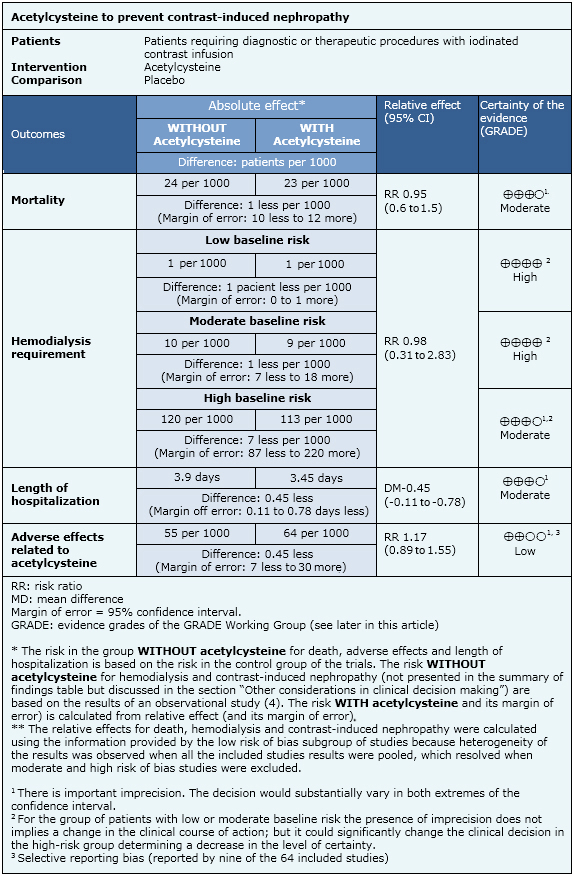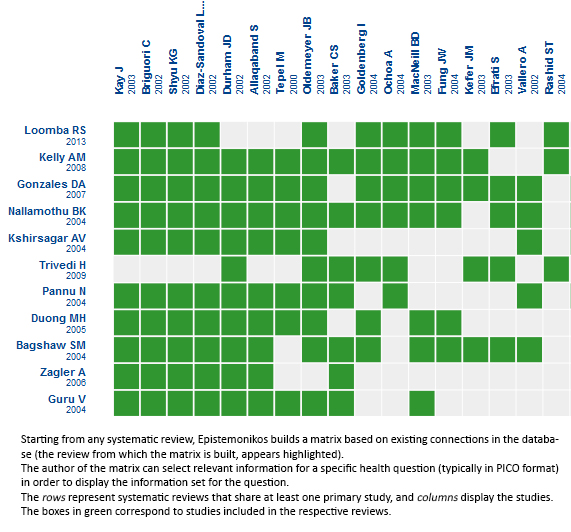Resúmenes Epistemonikos
← vista completaPublicado el 16 de abril de 2015 | http://doi.org/10.5867/medwave.2015.03.6122
¿Debe indicarse acetilcisteína para prevenir la nefropatía por contraste?
Should acetylcysteine be used to prevent contrast induced nephropathy?
Abstract
Diagnostic and therapeutic procedures that require the infusion of iodine containing contrast solutions are associated with the risk of contrast-induced nephropathy, a condition that can cause significant morbidity. Acetylcysteine has been proposed as a measure to prevent this condition. Searching in Epistemonikos database, which is maintained by screening 30 databases, we identified 20 systematic reviews including 64 randomized trials. We combined the evidence using meta-analysis and generated a summary of findings table following the GRADE approach. We concluded that even though acetylcysteine might not cause important adverse effects, it does not decrease need for dialysis, mortality or other important outcomes.
Problem
Diagnostic and therapeutic procedures requiring administration of iodinated contrast are frequently used in contemporary clinical practice. Contrast-induced nephropathy leads to significant morbidity [1],[2] and the risk is higher in procedures requiring more contrast [3],[4],[5]; as well as in patients older than 70 years, chronic renal disease, diabetes, cardiac failure or hypotension [4].
Acetylcysteine could prevent contrast-induced nephropathy and its consequences by modifying renal hemodynamics and reducing direct tissue oxidative injury.
Methods
We used Epistemonikos database, which is maintained by screening more than 30 databases, to identify systematic reviews and their included primary studies. With this information we generated a structured summary using a pre-established format, which includes key messages, a summary of the body of evidence (presented as an evidence matrix in Epistemonikos), meta-analysis of the total of studies, a summary of findings table following the GRADE approach and a table of other considerations for decision-making.
|
Key messages
|
About the body of evidence
|
What is the evidence. |
We identified 20 [7-26] systematic reviews including 64 randomized controlled trials [27-90].* |
| What types of patients were included. |
All the studies recruited patients that required diagnostic or therapeutic procedures with iodinated contrast infusion. The contrast-induced nephropathy baseline risk was variable. Overall, 10 030 patients were included in the identified randomized controlled trialss. |
|
What types of interventions were included. |
Intravenous or oral acetylcysteine. The dose varied between 2400 mg and 6000 mg. |
|
What types of outcomes were measured. |
All-cause mortality; hemodialysis requirement; contrast-induced nephropathy (creatinine increase); length of hospital stay; adverse effects. |
*For reasons of space, these references were not disaggregated. You can access them through the references section.
Summary of findings
Acetylcysteine effectiveness information is based on 64 randomized controlled trials that included 10 030 patients. Twelve studies reported all-cause mortality, 28 reported hemodialysis requirement, sixty-four reported contrast-induced nephropathy, eight reported length of hospital stay and nine reported adverse effects.
- Acetylcysteine does not reduce hemodialysis requirement in patients with low or moderate risk of contrast-induced nephropathy. The certainty of the evidence is high.
- Acetylcysteine probably does not reduce hemodialysis requirement in patients with high risk. The certainty of the evidence for this group is moderate.
- Acetylcysteine probably does not reduce mortality. The certainty of the evidence is moderate.
- Acetylcysteine probably leads to little or no difference in the length of hospital stay. The certainty of the evidence is moderate.
- Acetylcysteine might not be associated to clinically significant adverse effects, but the certainty of the evidence is low.

Other considerations for decision-making
|
To whom this evidence does and does not apply |
|
| About the outcomes included in this summary |
|
| Balance between benefits and risks, and certainty of the evidence |
|
| What would patients and their doctors think about this intervention |
|
| Resource considerations |
|
|
Differences between this summary and other sources |
|
| Could this evidence change in the future? |
|
How we conducted this summary
Using automated and collaborative means, we compiled all the relevant evidence for the question of interest and we present it as a matrix of evidence. An illustrative part of the matrix is shown.
 Full size
Full size Follow the link to access the interactive version N-acetylcysteine for prevention of contrast-induced nephropathy

Notes
The upper portion of the matrix of evidence will display a warning of “new evidence” if new systematic reviews are published after the publication of this summary. Even though the project considers the periodical update of these summaries, users are invited to comment in Medwave or to contact the authors through email if they find new evidence and the summary should be updated earlier. After creating an account in Epistemonikos, users will be able to save the matrixes and to receive automated notifications any time new evidence potentially relevant for the question appears.
The details about the methods used to produce these summaries are described here http://dx.doi.org/10.5867/medwave.2014.06.5997.
Epistemonikos foundation is a non-for-profit organization aiming to bring information closer to health decision-makers with technology. Its main development is Epistemonikos database (www.epistemonikos.org).
These summaries follow a rigorous process of internal peer review.
Conflicts of interest
The authors have completed the ICMJE uniform disclosure form for potential conflicts of interest, (available on request from the corresponding author), and declare not having conflicts of interest with the subject of the article.

